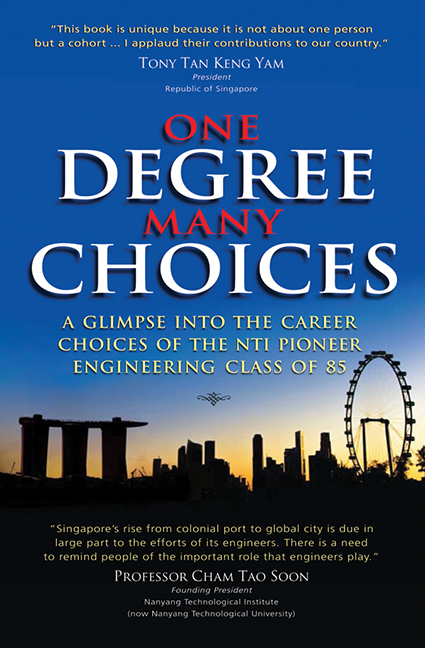 One Degree, Many Choices
One Degree, Many Choices Book contents
- Frontmatter
- Contents
- WHAT THIS BOOK IS ABOUT
- FOREWORD
- ACKNOWLEDGEMENTS
- INTRODUCTION It's All About Life Choices
- PART I THE BEGINING
- PART II ENGINEERING PURSUITS
- PART III THE LADY ENGINEERS
- PART IV NON-ENGINEERING PURSUITS
- PART V EPILOGUE
- CHAPTER 39 NTI's Impact in Retrospect
- CHAPTER 40 Engineering Education Then, Today & the Future
- CHAPTER 41 Competing for Talent
- CHAPTER 42 How I Benefitted
- CHAPTER 43 Compass at the Crossroads of Life
- APPENDICES
- THE SUPPORT TEAM
CHAPTER 40 - Engineering Education Then, Today & the Future
from PART V - EPILOGUE
Published online by Cambridge University Press: 21 October 2015
- Frontmatter
- Contents
- WHAT THIS BOOK IS ABOUT
- FOREWORD
- ACKNOWLEDGEMENTS
- INTRODUCTION It's All About Life Choices
- PART I THE BEGINING
- PART II ENGINEERING PURSUITS
- PART III THE LADY ENGINEERS
- PART IV NON-ENGINEERING PURSUITS
- PART V EPILOGUE
- CHAPTER 39 NTI's Impact in Retrospect
- CHAPTER 40 Engineering Education Then, Today & the Future
- CHAPTER 41 Competing for Talent
- CHAPTER 42 How I Benefitted
- CHAPTER 43 Compass at the Crossroads of Life
- APPENDICES
- THE SUPPORT TEAM
Summary
“Engineering education has to broaden.”
— Professor Bertil Andersson, NTU President (2011 – present)NTU'S COLLEGE OF ENGINEERING today has six schools and 16,000 students. It is one of the largest engineering colleges in the world. It was set up in 2001 to integrate and promote interaction within NTU's engineering disciplines.
Corporate bigwig Koh Boon Hwee took over from Dr Michael Fam as the chairman of the NTU council in 1993. The council is now the board of trustees. On his watch, he helmed the transformation of the university to one of growing international stature. A mechanical engineer by training, Boon Hwee has a ringside view of the changes in the engineering field over the years.
“The nature of engineering has gone through a sea change since I did my undergraduate study in mechanical engineering in the 1970s,” he said. “In the old days, the major engineering disciplines were mechanical, electrical and civil engineering. These stand-alone disciplines will not suffice in the modern world which requires a multi-disciplinary approach.”
The former Hewlett Packard Managing Director in Singapore gave an example. An inkjet printer cannot be built on mechanical engineering alone. There is a need to understand the electronics that enable the printer to spit out 60,000 ink dots in a controlled manner. The cross-disciplinary nature of engineering is very apparent at NTU. When NTI started, there were three engineering schools. Today, there are six.
“Engineering now is more inter-disciplinary within itself,” said Boon Hwee. “Engineers must also be able to work in a cross-disciplinary way with other faculties. While one can practise medicine the traditional way, progress in the field requires more integration with engineering. There is a growing need to interface engineering with medicine to create products and services that will further advance people's quality of life. Computer-assisted surgery is a good example.” As such, NTU is setting up a medical school which will start taking in students in 2013. “The students will tap on cutting-edge technology such as robotics to treat patients,” said ex-NTU President Su Guaning.
His successor Professor Bertil Andersson noted that over the past 15 years, the universities that won the most Nobel prizes are MIT, Stanford and Caltech. He said, “They have a strong engineering school on top of other disciplines. This means that nowadays engineering combined with other disciplines is driving discoveries.
- Type
- Chapter
- Information
- One Degree, Many ChoicesA Glimpse into the Career Choices of the NTI Pioneer Engineering Class of 85, pp. 164 - 168Publisher: ISEAS–Yusof Ishak InstitutePrint publication year: 2012


